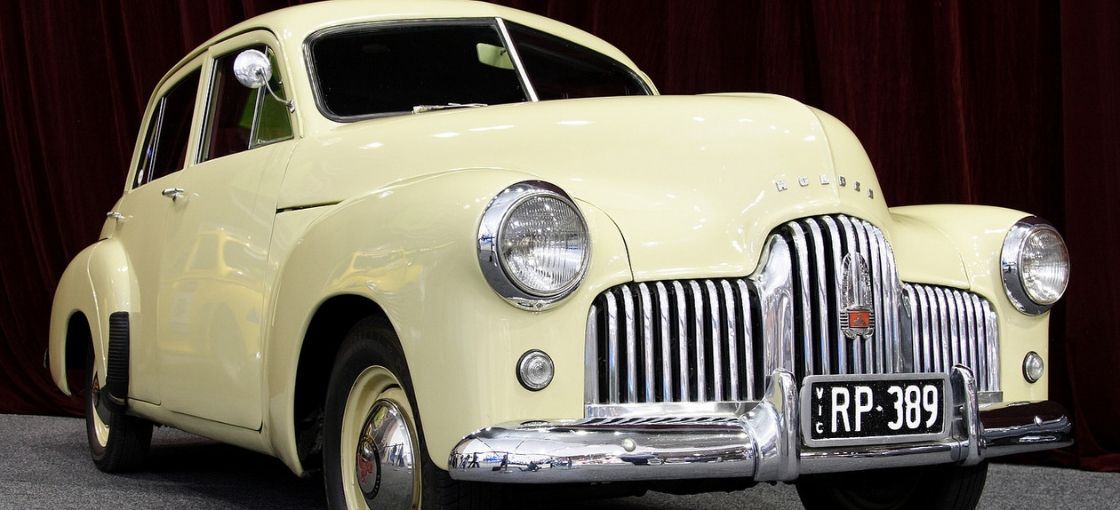Holden history: the early days

Win a car with Mater Cars for Cancer lottery
Here at Mater Cars for Cancer, we love cars! Having produced the first wholly Australian car in 1948, Holden has played a major role in our country’s automotive history. The company has a long history of its own. So let’s take a cruise back to where it all began.
Holden takes the wheel
James Alexander Holden was the man who started it all off in 1856 with a saddlery business in Adelaide. As technology evolved over the years, the company began servicing the automotive industry. Initially it offered car upholstery repairs and then producing vehicle body shells.
In 1924, Holden became the exclusive supplier of General Motors in Australia. Seven years later, the two companies merged to become General Motors-Holden’s Limited. And not long after, they opened new headquarters in Melbourne.
Near the end of World War II the Australian Government asked manufacturers to submit proposals for an Australian car. Having acquired technical and manufacturing expertise during the war, GM-H accepted and completed the challenge of building the nation’s first mass-produced car.
The first Holden car
The first Holden, the 48-215 sedan, was launched in 1948 by Prime Minister, Ben Chifley. ‘Made in Australia, for Australia‘ – nobody guessed what a runaway success this plain yet practical sedan would be. Australians took the Holden into their hearts and a love affair began that continues to this day. Demand for the 48-215 outstripped supply. The waiting list stretched through 1949 and beyond.
Despite its popularity, the Holden FX was far from luxurious and certainly no dream machine. In many ways, the bare bodied newcomer was the epitome of austerity. It had just one key-operated door lock (on the passenger’s door), no heater, no armrests and no carpet. It also had only one sun-visor on the driver’s side. There were no chrome mouldings. The ventilation was initiated with flipper windows and an adjustable scoop between the bonnet and windscreen. De-misting was carried out by whatever you had, a sleeve or handkerchief. As safety was not a major issue at the time due to fewer cars on the road, the 48/215 got away with having only one tail-light and no turn indicators.
The seats were trimmed in either woollen body cloth or leather. PVC material was introduced in mid 1951. You could pay to have additional features included. This would include a radio, a rear venetian blind, a left side sun-visor, a locking petrol cap and an air-cleaner. The exterior body came in four colours: Convoy Grey, Seine Blue, Gawler Cream and Black.
The lack of refinement in the first “all Australian” car had absolutely no effect on sales. In fact production rates rose from an initial 10 units a day to 100 per day in 1951.
The 48-215 engine
The success of the 48-215 rested largely with the reliability, durability and flexibility of its engine. The six-cylinder engine had a capacity of 2.15 litres. It produced 21.6 of horsepower and developed around 45kW of power.
Performance
Today we would think the performance to be laughable. But at the time, the 48-215 was considered a performance machine. It was able to cover 0–100 km/h in around 20 seconds, with a top speed of 130 km/h. This was much better than the four cylinder British cars of the time. And also not far behind the big and expensive American V8s.
Despite the high price, the 48-215 offered more value for money than any of its competitors. It was also adept at handling Australian conditions and pot-holed dirt roads. At this time many of the roads connecting the capital cities were yet to be fully sealed. The Holden stood the test where similarly priced British ‘fours’ were left by the roadside.
The Holden FX sold remarkably well and the range was expanded. In January 1951 a utility was added, then in July 1953 a business sedan (taxi version) appeared.
The Holden Coupe Utility
With primary industry prospering after WWII, Holden decided to design a utility for the man on the land. The Holden Coupe Utility (50-2106) was produced from January 1951.
The first Holden ute was light, strong and surprisingly fast, thanks to a modern six-cylinder, 21 hp engine. It was go-anywhere workhorse and perfect for rounding up sheep.
The Holden ute’s high power-to-weight ratio meant that drivers could carry loads over the toughest hills. It could cruise around at 105 km/h all day and operate on a remarkable overall fuel economy of 9.4L/100km.
Cheaper than any of its rivals, it was the answer to a farmer’s prayer – and the city dweller’s as well. So many people lusted after it that the waiting list grew to 70,000 in its first year on the market.
It’s your turn to win a car
You could win a HSV GTSR in Mater Cars for Cancer No. 76! Don’t miss out on this opportunity to own a powerful Holden.
